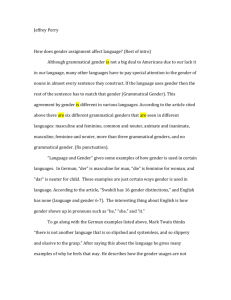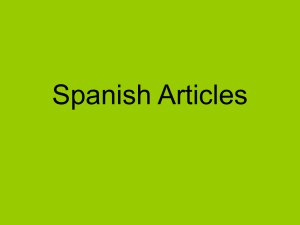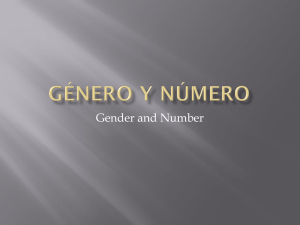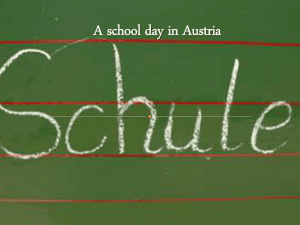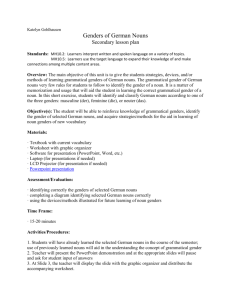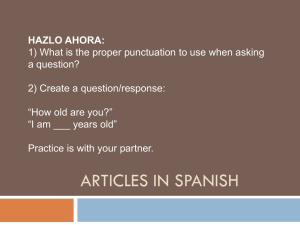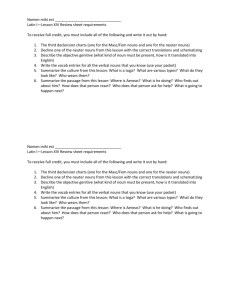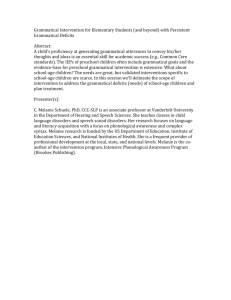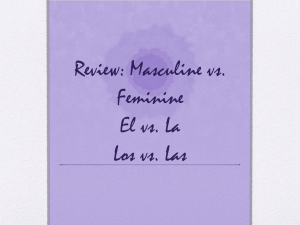5: Grammatical Gender
advertisement
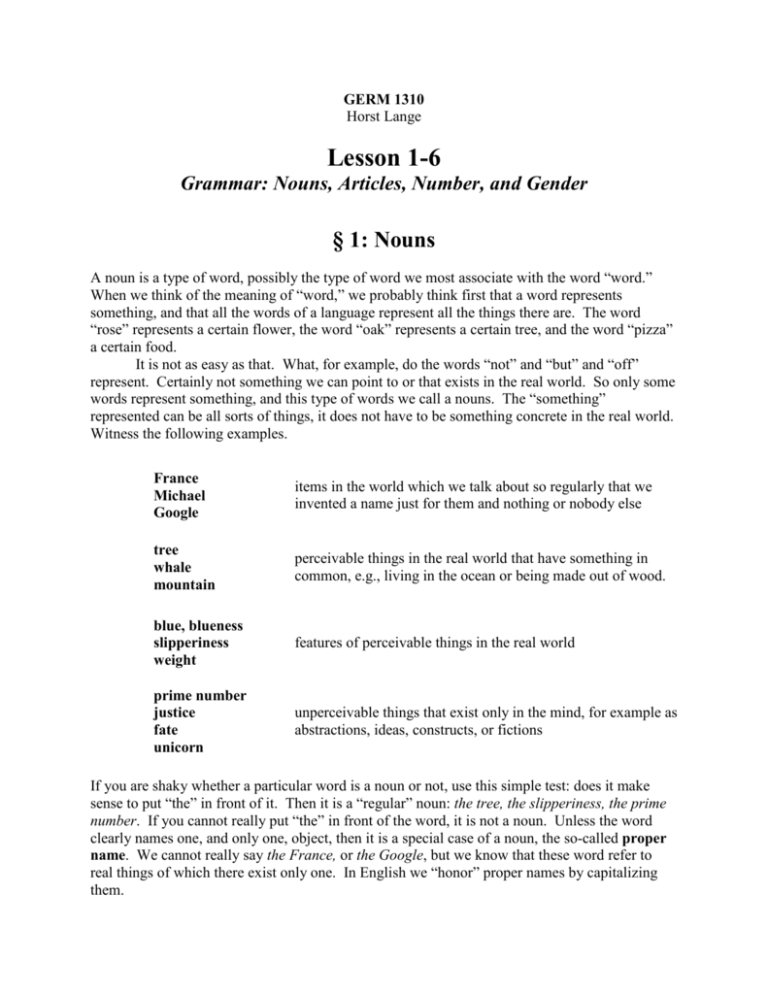
GERM 1310 Horst Lange Lesson 1-6 Grammar: Nouns, Articles, Number, and Gender § 1: Nouns A noun is a type of word, possibly the type of word we most associate with the word “word.” When we think of the meaning of “word,” we probably think first that a word represents something, and that all the words of a language represent all the things there are. The word “rose” represents a certain flower, the word “oak” represents a certain tree, and the word “pizza” a certain food. It is not as easy as that. What, for example, do the words “not” and “but” and “off” represent. Certainly not something we can point to or that exists in the real world. So only some words represent something, and this type of words we call a nouns. The “something” represented can be all sorts of things, it does not have to be something concrete in the real world. Witness the following examples. France Michael Google items in the world which we talk about so regularly that we invented a name just for them and nothing or nobody else tree whale mountain perceivable things in the real world that have something in common, e.g., living in the ocean or being made out of wood. blue, blueness slipperiness weight features of perceivable things in the real world prime number justice fate unicorn unperceivable things that exist only in the mind, for example as abstractions, ideas, constructs, or fictions If you are shaky whether a particular word is a noun or not, use this simple test: does it make sense to put “the” in front of it. Then it is a “regular” noun: the tree, the slipperiness, the prime number. If you cannot really put “the” in front of the word, it is not a noun. Unless the word clearly names one, and only one, object, then it is a special case of a noun, the so-called proper name. We cannot really say the France, or the Google, but we know that these word refer to real things of which there exist only one. In English we “honor” proper names by capitalizing them. § 2: Definite and Indefinite Articles A guy wakes up from a coma and exclaims urgently, again and again: “Song! Song!” The medical personnel wants to soothe his agitation, but is at a loss. Is he requesting his favorite song? Or just any song? If the patient had been more specific and said, “The song!”, his wife might know that he wanted to listen to Another One Bites The Dust, their wedding song. If he had said, “A song!”, the nurses simply could have tried to break out in Mary had a Little Lamb. It would have helped if the guy had used one more word, either the or a. For these reasons most Indo-European languages (which German and English are) have so-called articles. These are short words (e.g., the and a) preceding a noun (e.g., song) that make clear whether, on the one hand, one is talking about one specific item or one specific group of items, or, on the other, about some unspecified item. The article which specifies an item is called the definite article because in a manner of speaking it defines what one is talking about. In contradistinction, the article which leaves the reference open is called the indefinite article because it leaves the referent undefined. The following examples might help: definite article the indefinite article a, an “I want the boss to see this mess right now!" Only one, not any old boss will do! Everybody in the room knows who is meant. “This outfit needs a boss so badly it is not even funny.” The identity of the boss is not an issue; that somebody is in charge, on the other hand, is. § 3: German Articles German has definite and indefinite articles just like English, and they are more or less used the same way. So there should not be any difficulties, right? Unfortunately, there are. They have to do with the fact that German is a so-called inflected language (not quite a bad as Latin, for example, but still): this means that it uses lots of endings to create meaning. How that precisely works will be the subject of a number of future lessons, and probably is, at the same time, the most fun and most challenging aspect of German. Let us start with the fact that the simple English the and a translate into German in a variety of ways: the a = = der, die, das, des, dem, den ein, eine, eines, einer, einem, einen Holy smoke! Before continuing, please take two deep breaths and stop panicking. At this stage of the game, you do not have to understand these forms at all. But you should know two things. First, as you can check, the difference of the different translations rest entirely in the last two letters of the word. These are the so-called endings. Second, to bring order into this chaos, we have to learn what grammatical gender, grammatical number, and grammatical case are. For the purposes of sentences we are forming, hearing, and reading in the beginning chapters we soooo do not have to worry about that mysterious feature called case, because we will only work with the so-called nominative case. Other cases will be introduced step by controlled step, so as not to overcharge your synapses. Number is easily understood, and gender, well, gender is baffling at first, but will become second nature relatively soon. § 4: Grammatical Number It makes a difference whether you are talking about a single item or a plurality of them. A newly-wed couple might have a serious argument about whether they want to have children or just a child. To enable such arguments, our languages give us means to distinguish the two: note the different forms child and children. Child is in the form called, for obvious reasons, the singular, and children is the form called the plural. (In English and German, there are only these two grammatical numbers. Other languages, for example Polish or American Sign Language, have a so-called dual as well, i.e., a special form indicating that there are just two of a kind. If that ain’t funky, what is?) § 5: Grammatical Gender Compare the following sentences. This is Bobby. He is my cousin. This is Samantha. She is my roommate. What kind of book is this? It is rather large. Apparently, when we refer back to something in English, be it Bobby, Samantha, or a book, we feel the need to assign a gender to the item (masculine or feminine, he or she) or indicate, by using it, that it does not have a gender (that it is, as grammarians call it, neuter). In principle, we could be using just one word to do the trick in all three situations. The situation in German is similar: its grammar distinguishes between masculine, feminine, and neuter grammatical genders as well. But there are two important differences. The first one is that in German the grammatical gender is encoded, so to speak, into the articles that accompany the nouns. This encoding happens – surprise! – with the help of the endings. In the nominative case this happens by either translating the as der (masculine), as die (feminine), or as das (neuter). the man the woman the book der Mann die Frau das Buch masculine feminine neuter The other important difference lies in the fact that English assigns grammatical gender according to natural gender. It is only in respect to a male that we say he and to a female she. To an object that has neither X nor Y chromosomes we say it. At least English does that most of the times.1 But not always: in traditional formal language, a ship is a “she.” That’s why Scott in Star Trek – The Original Series says, referring to the Enterprise, “I don’t know, Captain, I don’t think she cannot take it anymore.” The same goes for countries. Yet these items are neither female nor particularly feminine. 1 German, however, does assign grammatical gender according to natural gender if there is one, just like English. But in the absence of natural gender it still assigns grammatical gender different from the neuter in a fashion that looks rather random. And that is weird for an English native speaker. This means that when you are learning a new noun, you have to learn its grammatical gender with it. This is being done by memorizing not just the noun, but the noun and its accompanying article: der, die, or das. That sounds overwhelming at first, and slows down language acquisition, but by the second semester most students do not perceive this as cruel and unusual punishment anymore. This is a task the brain just learns to handle. § 6: Table of Article Endings for the Nominative To help get the endings of articles straight, it is useful to create tables. In this course, the convention is to list the singular to the left and the plural to the right. In the plural, it does not matter whether some item’s grammatical gender is masculine, feminine, or neutral, since the articles have the same endings. In the singular, masculine is placed to the right, neuter to the left, and feminine in the middle. These are all the endings you have to know for the time being. Until further notification, we will use nouns only in the subject position, that is, nouns that denote the actor who does the activity talked about in the sentence. Singular Plural Masculine Feminine Neuter the der die das die a ein eine ein no plural exists § 7: Grammatical vs. Natural Gender As mentioned in § 5, German assigns grammatical gender to nouns that refer to objects that, for a sane person at least, do not have a natural gender. Why should die Ellipse (= ellipsis) be feminine? And why should der Kreis (= circle) be masculine? And why should das Quadrat (= square) be neuter? What about these geometrical objects make them belong to different genders? Why should der Löffel (= spoon) be masculine? Why should die Gabel (= fork) be feminine? And why should das Messer be neuter? Does this make any sense? No it doesn’t. And never try to find logic behind this. There is none, and if you persist, chances are you will descend into madness. This state of things has some people claiming that Germans (and speakers of other IndoEuropean languages that do this grammatical gender spiel) have weird sexual obsessions that makes them genderize the entire world. This is a ridiculous theory based on the confusion generated by the dolts who came up with the names for grammatical gender. Instead of calling the various nouns masculine, feminine, and neuter, they should have called them members of the der-group, the die-group, and the das-group, and they should have observed that nouns are most of the time assigned to each group randomly. And then they could point out that mercifully there is one helpful rule that makes all male objects part of the der-group and all female objects part of the die-group. But this rule of course does not imply that other nouns that are part of, say, the der-group are somehow considered to be male. For reasons you will learn later, the German language, in order to create meaning, in order to, for example, make clear who does what to whom, needs an ending system, and an ending system, to function efficiently, needs to assign nouns more or less randomly to three different groups. If we look at things this way, we can understand as well why objects that actually have natural gender sometimes do not belong to the corresponding grammatical gender. Germans say das Mädchen, although a girl is clearly female! Some people like to point out that der Junge or der Bube (= boy) is masculine, and conclude that German is a particularly nasty sexist language that gives boys masculinity and reduces girls to neutered objects. How wrong they are! Das Mädchen is neuter, because it is a noun ending in –chen, and there is a rule that all these nouns are neuter. (By the way, the chen-ending has its equivalent in English, namely –kin: witness pumpkin, bumpkin, gherkin, or munchkin). –chen as well as –kin are so-called diminutives, expressing the smallness of an object, so the literal translation of das Mädchen is just little maid (= Mäd!). And we can “neuter” the boy as well by calling him das Bübchen. No sexism here, just the attempt of the language to use terms of endearment. It would be logical to begin talking only about the der-, the die-, and the das-group instead of the masculine, the feminine, and the neuter, but since the entire world is doing it the old and confusing way, we will go with the flow and use this terminology as well. Now you know where the pitfalls are.
